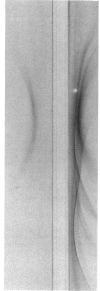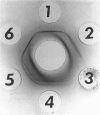Abstract
It is now generally accepted that acute post-streptococcal glomerulonephritis (PSGN) is the consequence of the formation of antigen-antibody-complement complexes on the basement membrane of the glomerulus and that the antigen is of streptococcal origin. In cases of acute PSGN a high titre of specific antibodies to a streptococcal cytoplasmic extract can be found at the very beginning of the disease. This cytoplasmic antigen which we called endostreptosin (ESS) is probably the pathogenetic antigen of glomerulonephritis. It is deposited on the subendothelial side of the basement membrane in the first few days of the disease and is rapidly covered by newly-formed and specific antibody and complement with resultant immune injury causing signs and symptoms of symptomatic but also frequently asymptomatic acute glomerulonephritis. To further characterize and isolate ESS we used immunoaffinity chromatography and Western blotting techniques. PAGE analysis of the affinity-isolated ESS revealed the major component to have a molecular weight of approximately 45 kD. Sera from patients with PSGN or sera of rabbits immunized with affinity-isolated ESS reacted by Western blotting with at least one antigenic component with a molecular weight of approximately 45 kD. Normal human sera or the sera of non-immunized rabbits failed to demonstrate activity against this antigen. The basement membranes of the glomeruli of patients with very early PSGN stain with fluorescein-labelled gammaglobulin of patients with glomerulonephritis. This staining can be prevented when these sera are pre-absorbed with ESS but not by pre-absorption with intact cells or cytoplasmic extracts of other bacteria.
Full text
PDF





Images in this article
Selected References
These references are in PubMed. This may not be the complete list of references from this article.
- Andres G. A., Accinni L., Hsu K. C., Zabriskie J. B., Seegal B. C. Electron microscopic studies of human glomerulonephritis with ferritin-conjugated antibody. Localization of antigen-antibody complexes in glomerular structures of patients with acute glomerulonephritis. J Exp Med. 1966 Feb 1;123(2):399–412. doi: 10.1084/jem.123.2.399. [DOI] [PMC free article] [PubMed] [Google Scholar]
- Avrameas S., Ternynck T. Biologically active water-insoluble protein polymers. I. Their use for isolation of antigens and antibodies. J Biol Chem. 1967 Apr 10;242(7):1651–1659. [PubMed] [Google Scholar]
- Bradford M. M. A rapid and sensitive method for the quantitation of microgram quantities of protein utilizing the principle of protein-dye binding. Anal Biochem. 1976 May 7;72:248–254. doi: 10.1016/0003-2697(76)90527-3. [DOI] [PubMed] [Google Scholar]
- Dodge W. F., Spargo B. H., Travis L. B. Occurrence of acute glomerulonephritis in sibling contacts of children with sporadic acute glomerulonephritis. Pediatrics. 1967 Dec;40(6):1028–1030. [PubMed] [Google Scholar]
- Engvall E., Perlmann P. Enzyme-linked immunosorbent assay, Elisa. 3. Quantitation of specific antibodies by enzyme-labeled anti-immunoglobulin in antigen-coated tubes. J Immunol. 1972 Jul;109(1):129–135. [PubMed] [Google Scholar]
- FREEDMAN P., PETERS J. H., KARK R. M. Localization of gamma-globulin in the diseased kidney. Arch Intern Med. 1960 Apr;105:524–535. doi: 10.1001/archinte.1960.00270160022005. [DOI] [PubMed] [Google Scholar]
- Golbus S. M., Wilson C. B. Experimental glomerulonephritis induced by in situ formation of immune complexes in glomerular capillary wall. Kidney Int. 1979 Aug;16(2):148–157. doi: 10.1038/ki.1979.116. [DOI] [PubMed] [Google Scholar]
- Gozzo J. J., Gottschalk R., O'Brien P., Cronin W., Monaco A. P. Use of heterogenous and monospecific antisera for the diagnosis of bladder cancer. J Urol. 1977 Nov;118(5):748–751. doi: 10.1016/s0022-5347(17)58180-x. [DOI] [PubMed] [Google Scholar]
- Laemmli U. K. Cleavage of structural proteins during the assembly of the head of bacteriophage T4. Nature. 1970 Aug 15;227(5259):680–685. doi: 10.1038/227680a0. [DOI] [PubMed] [Google Scholar]
- Lange K., Ahmed U., Kleinberger H., Treser G. A hitherto unknown streptococcal antigen and its probable relation to acute poststreptococcal glomerulonephritis. Clin Nephrol. 1976 May;5(5):207–215. [PubMed] [Google Scholar]
- Lange K., Seligson G., Cronin W. Evidence for the in situ origin of poststreptococcal glomerulonephritis: glomerular localization of endostreptosin and the clinical significance of the subsequent antibody response. Clin Nephrol. 1983 Jan;19(1):3–10. [PubMed] [Google Scholar]
- Lange K., Semar M., Ty A., Treser G. A specific antigen and antibody in acute poststreptococcal glomerulonephritis. Trans Assoc Am Physicians. 1969;82:188–200. [PubMed] [Google Scholar]
- Lange K., Treser G., Ty A., Wasserman E. The histologic and immunologic features of acute, subacute and chronic glomerulonephritis. Trans Assoc Am Physicians. 1965;78:117–134. [PubMed] [Google Scholar]
- RINDERKNECHT H. Ultra-rapid fluorescent labelling of proteins. Nature. 1962 Jan 13;193:167–168. doi: 10.1038/193167b0. [DOI] [PubMed] [Google Scholar]
- Rodríguez-Iturbe B. Epidemic poststreptococcal glomerulonephritis. Kidney Int. 1984 Jan;25(1):129–136. doi: 10.1038/ki.1984.19. [DOI] [PubMed] [Google Scholar]
- Sagel I., Treser G., Ty A., Yoshizawa N., Kleinberger H., Yuceoglu A. M., Wasserman E., Lange K. Occurrence and nature of glomerular lesions after group A streptococci infections in children. Ann Intern Med. 1973 Oct;79(4):492–499. doi: 10.7326/0003-4819-79-4-492. [DOI] [PubMed] [Google Scholar]
- Seligson G., Lange K., Majeed H. A., Deol H., Cronin W., Bovie R. Significance of endostreptosin antibody titers in poststreptococcal glomerulonephritis. Clin Nephrol. 1985 Aug;24(2):69–75. [PubMed] [Google Scholar]
- Sinniah R., Law C. H., Pwee H. S. Glomerular lesions in patients with asymptomatic persistent andorthostatic proteinuria discovered on routine medical examination. Clin Nephrol. 1977 Jan;7(1):1–14. [PubMed] [Google Scholar]
- Sinniah R., Pwee H. S., Lim C. H. Glomerular lesions in asymptomatic microscopic hematuria discovered on routine medical examination. Clin Nephrol. 1976 May;5(5):216–228. [PubMed] [Google Scholar]
- Solling J., Olsen S. Circulating immune complexes in glomerulonephritis. Clin Nephrol. 1981 Aug;16(2):63–74. [PubMed] [Google Scholar]
- Towbin H., Staehelin T., Gordon J. Electrophoretic transfer of proteins from polyacrylamide gels to nitrocellulose sheets: procedure and some applications. Proc Natl Acad Sci U S A. 1979 Sep;76(9):4350–4354. doi: 10.1073/pnas.76.9.4350. [DOI] [PMC free article] [PubMed] [Google Scholar]
- Treser G., Semar M., Ty A., Agel I., Franklin M. A., Lange K. Partial characterization of antigenic streptococcal plasma membrane components in acute glomerulonephritis. J Clin Invest. 1970 Apr;49(4):762–768. doi: 10.1172/JCI106289. [DOI] [PMC free article] [PubMed] [Google Scholar]
- Villarreal H., Jr, Fischetti V. A., van de Rijn I., Zabriskie J. B. The occurrence of a protein in the extracellular products of streptococci isolated from patients with acute glomerulonephritis. J Exp Med. 1979 Feb 1;149(2):459–472. doi: 10.1084/jem.149.2.459. [DOI] [PMC free article] [PubMed] [Google Scholar]
- Yoshizawa N., Treser G., Sagel I., Ty A., Ahmed U., Lange K. Demonstration of antigenic sites in glomeruli of patients with acute poststreptococcal glomerulonephritis by immunofluorescein and immunoferritin technics. Am J Pathol. 1973 Jan;70(1):131–150. [PMC free article] [PubMed] [Google Scholar]






